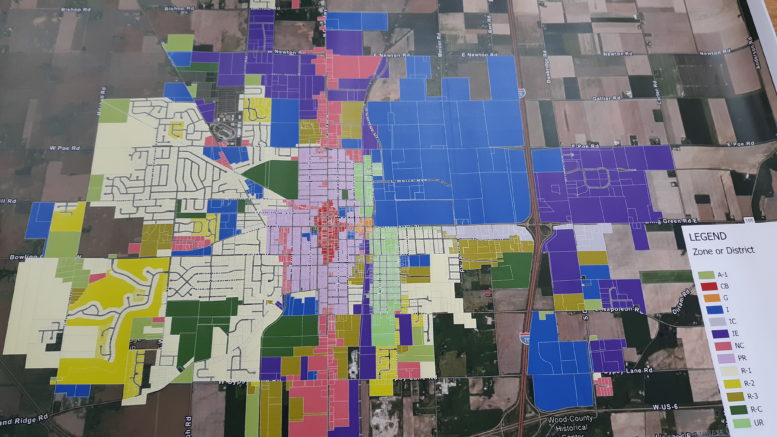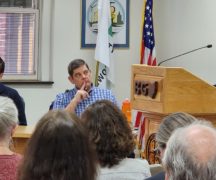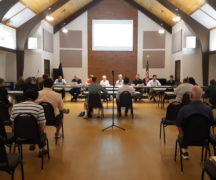By JAN LARSON McLAUGHLIN
BG Independent News
Bowling Green Planning Commission voted 7-1 Wednesday evening to recommend the city adopt a new zoning map allowing businesses and residential neighborhoods to coexist.
Voting in favor of the new pedestrian residential zoning were Bob McOmber, Wil Airhart, Abhishek Bhati, Judy Ennis, Mark Remeis, Nate Spitler and Tom Stalter. The sole vote against the zoning change came from Erica Sleek, who owns two existing businesses in an area to be rezoned.
The proposed “pedestrian residential” zoning has been a hot button issue for the planning commission and residents in the area of Buttonwood, South Maple and Eberly streets.
The planning commission adheres to the theory that certain small businesses can benefit walkable residential neighborhoods. But a handful of residents on the west side of Main Street believe they already have enough businesses as neighbors.
David Wilson, who lives on Eberly Avenue, told city officials that the proposed zoning code update will lead people to leave or file a referendum against the new zoning.
“You may have plans to impart your forced will and compliance on us or force us to leave and take our city taxes and school tax money with us,” Wilson told City Council members Monday evening and repeated to Planning Commission members on Wednesday evening.
“If you approve of such a plan, we the citizens, residents will need to take action to force the city to a referendum, and take it to a vote by the district’s tax paying citizens, residents, property owners at the city’s expense of time, money and public exposure of your actions and proclivities,” Wilson added.
While national trends show many communities trying to integrate walkable neighborhood businesses in residential areas, Wilson has repeatedly told city officials that the “social experiment” is unfair to residents.
“We citizens of BG of many years, and most born and raised here, moved and invested in this R-2 district for what it was and is,” Wilson said.
Fern Larking Kao, who lives on Buttonwood Avenue, expressed concern that her neighbors aren’t aware of the potential zoning change.
And Peg Baker, of Eberly Avenue, asked the planning commission to reconsider.
“As I walk the neighborhood, I don’t understand why you are changing the zoning,” said Baker, who has lived in her home for 30 years. The area is already home to businesses such as offices, a heating business, a storage facility, and a day care and private school.
“I’m just passionate about keeping the neighborhood as it is,” Baker said.
Bob McOmber, president of the planning commission, explained the city has “no ulterior motives” other than to fulfill its eight years of planning to integrate small businesses into neighborhood settings.
While neighbors who have protested the zoning change seem to assume businesses are bad for residential areas, “we don’t share that sentiment,” McOmber said.
This isn’t a rash decision made by the planning commission, he explained. “This has been in the making for at least eight years.”
Remeis added that the relationships between businesses and residents doesn’t have to be negative. “In the vast majority of places, the businesses get along with residents,” he said.
But Wilson interjected, “We live there. You don’t.”
At one point in the meeting, McOmber had to caution Wilson to stop interrupting planning commission discussion.
Airhart explained that in order to grow, cities cannot stay stagnant.
“Communities change and evolve over time,” he said. “We can’t stay rooted in one moment.”
Airhart said it’s unrealistic for homeowners to believe that when they purchase their properties that the surrounding areas are guaranteed to remain the same.
“That’s not how society works,” he said.
The planning commission discussed options that might make the zoning change more palatable to residents.
One option was to set restrictions such as hours of operation, decibel limits and the restricting of businesses to corner lots. The rationale for the corner lots was that they have more visibility, potentially have more street parking, and would add to the predictability of business locations.
“I think we should be more open,” Remeis said, citing the example of allowing an attorney to locate an office in the middle of a block on Church Street. Flexibility is needed, he said.
“I fully believe that’s the direction our town needs to go for positive growth,” Remeis said.
The planning commission briefly discussed reducing the blocks on the west side of Main Street, so the pedestrian residential zoning would end at Maple Street.
And Bhati introduced the idea that residents should have a role in deciding what type of businesses locate in their neighborhoods.
“Residents should have a say,” he said. “If the residents don’t want a cafe to be there, the cafe shouldn’t be there.”
But Spitler asked if residents would be allowed to vote on all prospective businesses – noting that it is already a “slog” for new businesses to get started.
Sleek suggested that the proposed pedestrian residential zoning be left R-2 residential.
“We clearly don’t need more businesses,” she said. “It’s already intermixed. I hear the complaints of the people there.”
But McOmber said city officials don’t believe in the premise that all business is bad in residential areas.
“What you’re suggesting is throwing out this zoning code,” McOmber said.
Sleek said the planning commission needs to listen to the residents.
“I’m listening to the community,” she said. “Why can’t we compromise?”
But Remeis said Sleek wasn’t offering a middle ground.
“You don’t want to compromise. You want to take it all away,” he said.
Sleek said there are some large properties in the proposed pedestrian residential zoning area, such as her businesses, that would be sizable enough for a large gas station to locate.
But Spitler noted that gas stations are not allowed in the pedestrian residential zoning.
Spitler stated that the planning commission has only heard from a handful of residents on the issue. “While I respect their opinions,” they don’t represent a large number of neighbors, he said.
Remeis pointed out that people in favor of the zoning are less likely to attend public meetings.
“Just because we haven’t heard from them doesn’t mean they don’t exist,” he said.
The next planning commission meeting will be held on Sept. 7, at 7 p.m., when public comments will again be accepted on the proposed zoning update. The planning commission will make a recommendation to City Council, which will have the final say on the zoning code.





